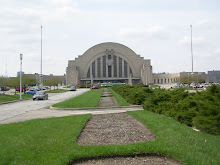Top 6 answers on the board . . .
1. Music Hall (1878)
1. Music Hall (1878)

 Music Hall takes first place predominately for its uniqueness as a building type, exuberant High Victorian Gothic details, and its listing as a National Historic Landmark. It edges out number two on the survey because of its setting on Washington Park and proximity to Nast Trinity Episcopal Church, designed by Hannaford and completed in 1880, and Memorial Hall completed in 1908 and designed by his sons.
Music Hall takes first place predominately for its uniqueness as a building type, exuberant High Victorian Gothic details, and its listing as a National Historic Landmark. It edges out number two on the survey because of its setting on Washington Park and proximity to Nast Trinity Episcopal Church, designed by Hannaford and completed in 1880, and Memorial Hall completed in 1908 and designed by his sons.2. City Hall (1893)


3. Corner of 9th & Race Streets
Including Brittany Apartments (1885), Saxony Apartments (1891), and the Phoenix Club (1893). Also around the corner is the Fechheimer Residence (1862) at 22 Garfield Place.
Including Brittany Apartments (1885), Saxony Apartments (1891), and the Phoenix Club (1893). Also around the corner is the Fechheimer Residence (1862) at 22 Garfield Place.


4. Winton Place
Including Samuel Hannaford Residence (1865), Winton Place Methodist Church (1885), Parsonage (1889), St. Stephen's Episcopal Church (1887), and Norman Chapel (1880) at Spring Grove Cemetery.
Including Samuel Hannaford Residence (1865), Winton Place Methodist Church (1885), Parsonage (1889), St. Stephen's Episcopal Church (1887), and Norman Chapel (1880) at Spring Grove Cemetery.



 Samuel Hannaford served as the only mayor of Winton Place before it was annexed to Cincinnati in 1903. The neighborhood has changed over the years but it as a whole, in my opinion, needed to be included. Individually there are probably nicer buildings that I could have included. Notice the "SH" carved in the gable end of his house. And Samuel Hannaford is also buried at Spring Grove Cemetery (a National Historic Landmark also) in Section 110, Lot 437, Space 9. Oddly enough, he wanted apparently no headstone and his plot remains unmarked. He and his wives basically rest in this area, under and near the tree.
Samuel Hannaford served as the only mayor of Winton Place before it was annexed to Cincinnati in 1903. The neighborhood has changed over the years but it as a whole, in my opinion, needed to be included. Individually there are probably nicer buildings that I could have included. Notice the "SH" carved in the gable end of his house. And Samuel Hannaford is also buried at Spring Grove Cemetery (a National Historic Landmark also) in Section 110, Lot 437, Space 9. Oddly enough, he wanted apparently no headstone and his plot remains unmarked. He and his wives basically rest in this area, under and near the tree.
5. Eden Park
Including Elsinore Tower (1883), Eden Park Water Tower (1894), and Pumping Station (1889)
Including Elsinore Tower (1883), Eden Park Water Tower (1894), and Pumping Station (1889)



6. Westwood United Methodist Church (1897)

 Samuel Hannaford (1835 – 1911) practiced architecture here from 1857 to his retirement in 1904. He worked solo, with various partners, and eventually with his sons, Harvey and Charles, who continued the practice after their father’s retirement and death. Nearly every neighborhood has a building by him and he left a considerable legacy on Cincinnati’s built environment.
Samuel Hannaford (1835 – 1911) practiced architecture here from 1857 to his retirement in 1904. He worked solo, with various partners, and eventually with his sons, Harvey and Charles, who continued the practice after their father’s retirement and death. Nearly every neighborhood has a building by him and he left a considerable legacy on Cincinnati’s built environment.For this list, I generally looked at only work completed before his retirement so buildings completed by his sons like the Ohio Mechanics Institute and the Times-Star Building were not considered. Many buildings, structures, and locals have been left off the list. Also-rans for me include Cincinnati Observatory (1873) and adjacent Ormsby McKnight Mitchel Building (1904), Old St. George (1872), and a number of buildings and homes in Clifton (For example Russell House – 1890 and Cox Residence – 1895, both at Brookline & Wentworth Avenues), Walnut Hills, and Avondale.




 Do you have a favorite you think should be on the list – Palace (now Cincinnatian) Hotel, Alms & Doepke Department Store, Lombardy Building, Episcopal Church of the Resurrection (now St. Luke’s in Saylor Park), and the Episcopal Church of our Savior in Mt. Auburn to name just a few? Let me know about it.
Do you have a favorite you think should be on the list – Palace (now Cincinnatian) Hotel, Alms & Doepke Department Store, Lombardy Building, Episcopal Church of the Resurrection (now St. Luke’s in Saylor Park), and the Episcopal Church of our Savior in Mt. Auburn to name just a few? Let me know about it.
A great online reference for all these buildings and more is The Legacy of Samuel Hannaford by Betty Ann Smiddy. All research came from that website along with John Clubbe’s book Cincinnati Observed, a 1999 article that appeared in the Cincinnati Post, and from wintonplace.org.
Historic photos from Library’s Cincinnati Memory Project.
.jpg)

4 comments:
I touched up the Wikipedia page on Hannaford slightly using some of this info. And I linked to this post from that page. Thought you might want to know.
Hello - Dan, please correct the spelling of Betty Ann Smiddy's name. She is the author of The Legacy of Samuel Hannaford (http://www.samuelhannaford.info)
It is interesting that Wikipedia needed touching up - they used Betty's site as a reference. I am not going to proof read it all, but simply issue a caution about historical information in the second or third hand not always being accurate.
Thanks.
Constance - Thanks for the correction. i didn't see your comment until today. I have corrected it.
Post a Comment